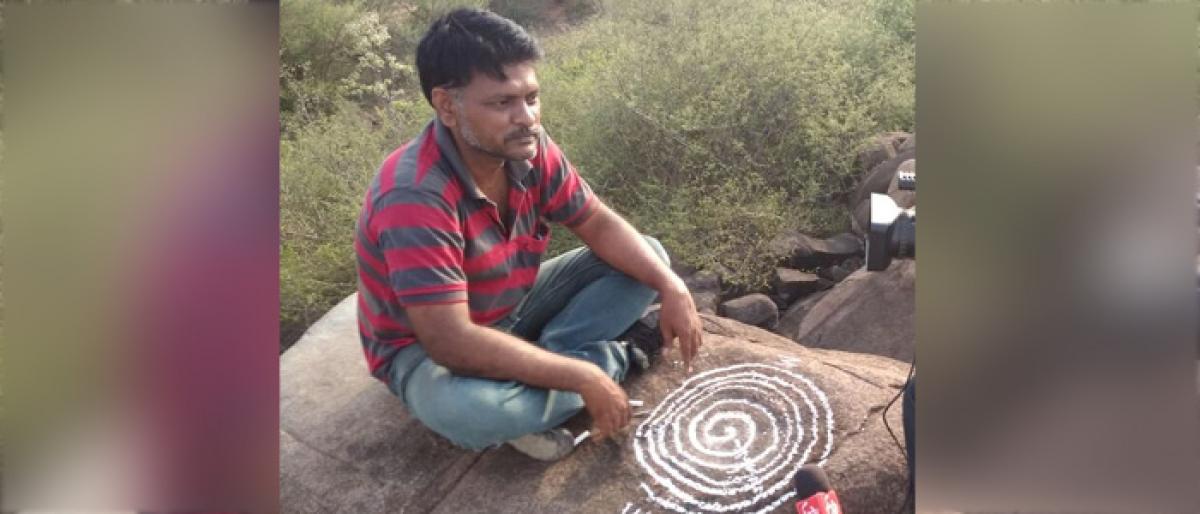Live
- Danam’s family owns total assets worth about Rs 58 cr
- DCA seizes medicines with misleading advertisements
- Naveen unveils BJD roadmap to make Odisha No.1 State
- Social media posts influence over 50% youngsters in city
- KCR is mentally imbalanced
- SWG pipe industry on verge of closure: State SWG pipe industry stares at grim future as orders dry up
- Visakhapatnam: YSRCP candidates file nominations amid fanfare
- Congress party finalises Lok Sabha candidates in AP, Telangana
- Zomato Tests Priority Delivery: Pay Extra for Faster Delivery
- Vizianagaram: Aditi Gajapathi Raju files nomination papers
Just In

A petroglyph sundial atop one of many a sonorous rock spread in Janagaon region that came to fore recently is just another slice of hidden history yet to be unravelled. Long before the advent of clock, sun was the only source to distinguish time. The sundials used a pointed rod, which cast shadows along certain points of a dial to indicate hours.
Janagaon: A petroglyph sundial atop one of many a sonorous rock spread in Janagaon region that came to fore recently is just another slice of hidden history yet to be unravelled. Long before the advent of clock, sun was the only source to distinguish time. The sundials used a pointed rod, which cast shadows along certain points of a dial to indicate hours.
The sonorous rocks (also known as lithophonic rocks), which produce musical sounds when struck, spread over 30 km, are treasure trove of relics belonging to ancient civilisation stretching to Satavahana and Kakatiya times. History enthusiast R Ratnakar Reddy, who had extensively explored the region and came up with several findings, has come up with another revelation – sundial.
He found a sundial atop Solamile Ene rock, a habitation in Katkoor panchayat under Bachannapet mandal, around 90 km northeast of Hyderabad. It may be noted here that Solamile Ene is self-descriptive. As the rock is 16 miles away from Janagaon town, it earned the name of Solamile (16 miles) Ene (hilly area).
Speaking to The Hans India, Reddy said: “There is quite some evidence that tell prehistoric man lived in this region. This spiral-shaped sundial on the bedrock of the Solamile Ene is believed to be of 1000 BC. However, it needs a study to establish the fact. There are six spirals that indicate time from 6 am to 11 am. At noon, the shadow of the pointing rod, which is placed in the centre of sundial, falls exactly on it; indicating that it was midday.”
Further he opined that the ancient man-made use of the various musical sounds of the sonorous rocks to indicate the time to his fellow habitats. Responding to this newspaper’s query that whether he had tested the veracity of the time using the sundial, Reddy said that he had stayed on the hillock for about three hours and found it was working. Although he tried to stay more time on the hillock, the objection was raised by the residents of VSR Nagar hamlet.
It’s learnt that residents have been trying to keep the historic rock under wraps fearing their displacement in case the government agencies take over the hillock. Meanwhile it’s learnt that a team of scholars headed by Prof KP Rao of University of Hyderabad (UoH), which is on a mission to bring the life that spanned through Neolithic, Megalithic and early historic periods near Konney village, 10 km away from sundial location atop Solamile Ene rock, have found turquoise beads of Neolithic times, besides earthen pots, terracotta artefacts, and charred grains.

© 2024 Hyderabad Media House Limited/The Hans India. All rights reserved. Powered by hocalwire.com







